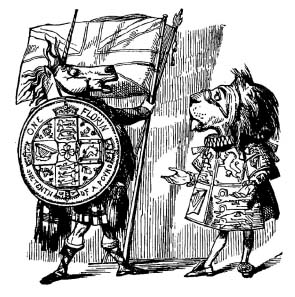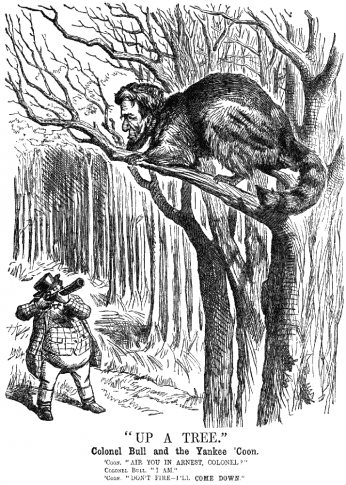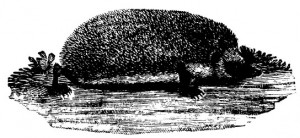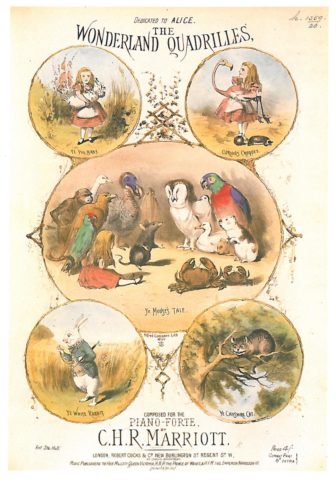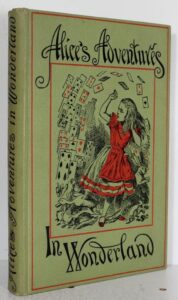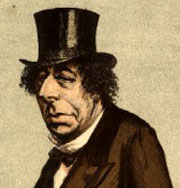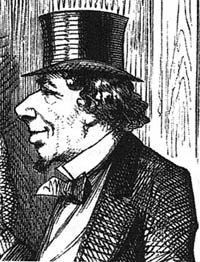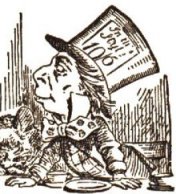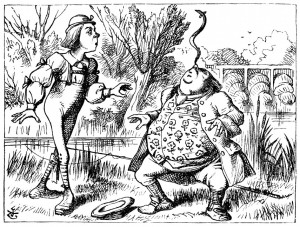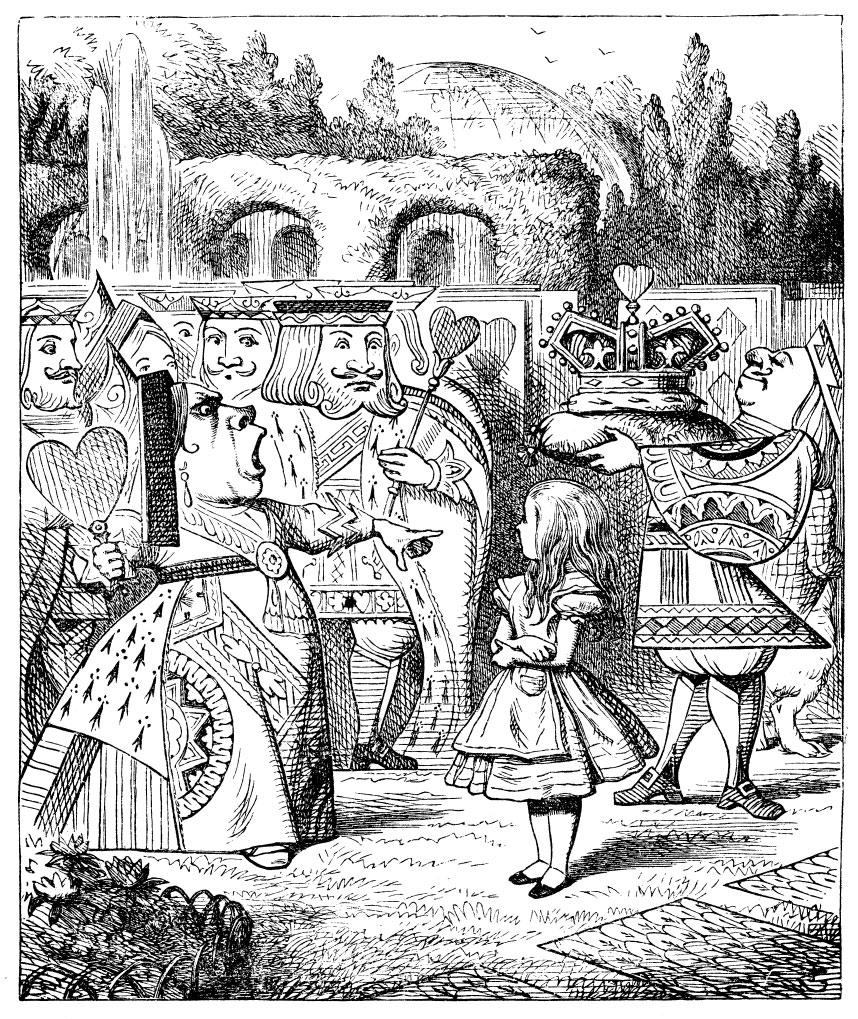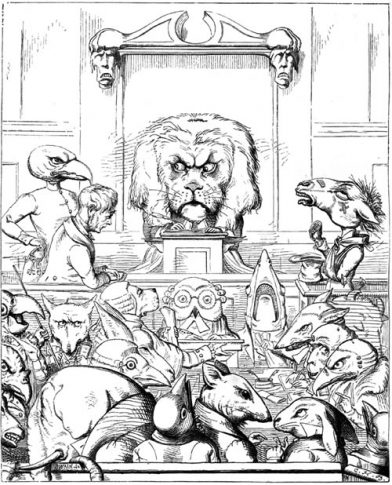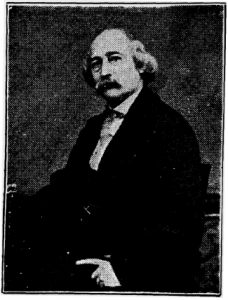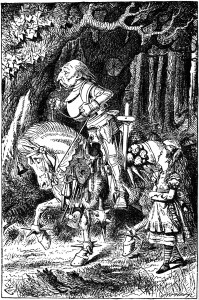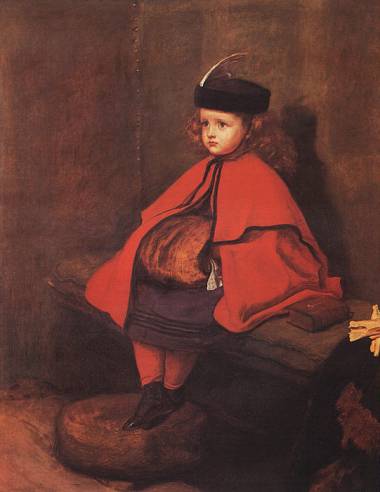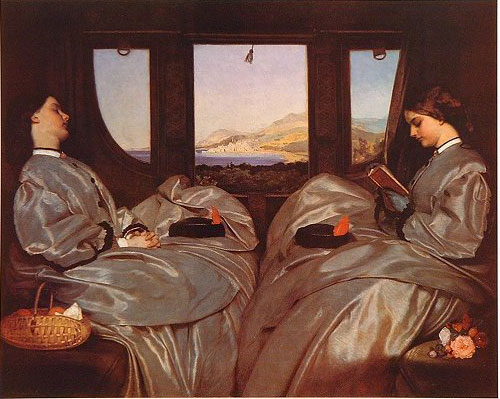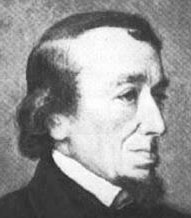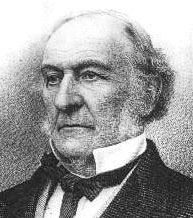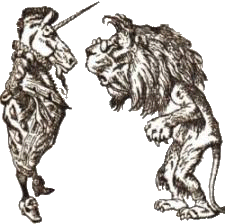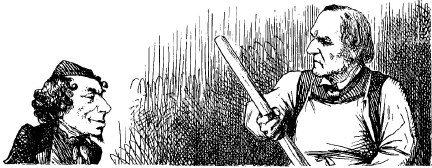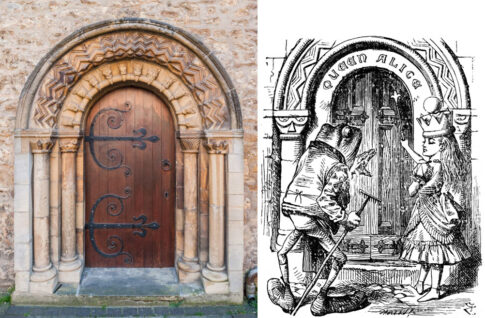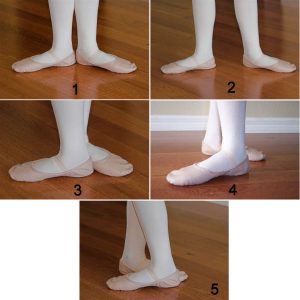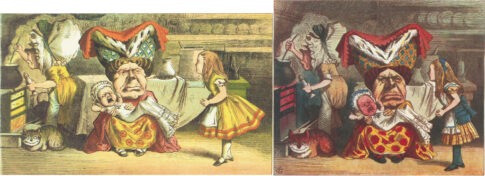Picture origins
Lewis Carroll is not the only one who based his work on elements out of his environment. Sir John Tenniel was an experienced illustrator and obviously had his own style. He also took pride in the fact that he could draw from memory in stead of needing a model. He once remarked: “Anything I see I remember”. Therefore, it is no surprise that some of the characters he drew for “Alice’s Adventures in Wonderland” and “Through the Looking-Glass” bear clear resemblance to his earlier work, for example his illustrations for the magazine “Punch”.
He may also have worked in some things he saw when visiting Oxford. Besides that, he may have purposely added some references to well-known people and aspects of his society into his illustrations – on request of Lewis Carroll or on his own initiative.
Note that mistakes in Tenniel’s illustrations are described elsewhere on this site.
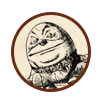
`Now I declare that’s too bad!’ Humpty Dumpty cried, breaking into a sudden passion. `You’ve been listening at doors — and behind trees — and down chimneys — or you couldn’t have known it!’
`I haven’t, indeed!’ Alice said very gently. `It’s in a book.’
`Ah, well! They may write such things in a book,’ Humpty Dumpty said in a calmer tone. `That’s what you call a History of England, that is.
Earlier work
Not all illustrations have deeper meanings. However, it is still possible to trace some of their origins, as Tenniel had a distinct way of drawing certain animals and people. That is why we can find many resemblances to the illustrations he did for the ‘Alice’ books in his earlier works. We can even find other “Alice’s” before the Alice in Wonderland books were published! Here are some examples of Tenniel’s earlier illustrations, in which we can clearly see characters that also appear in his illustrations for Carroll’s books.
Not only the characteristics of people and animals Tenniel drew for Wonderland show resemblances to his earlier work – also some scenes and their perspective can be recognised as they are typical of his style. For example, his “Up a Tree” Punch cartoon from 1862 bears many similarities to the scene where Alice speaks to the Cheshire Cat (Hancher, 2019 11-12).
Even though John Tenniel took pride in the fact that he was usually able to draw accurate illustrations by head, without having to study objects or use models, he must have sometimes consulted other sources. Look at this hedgehog from Thomas Bewick from “A General History of Quadrupets” (1790) – it is almost certain that Tenniel consulted this illustration when he drew the illustration of Alice with a flamingo and hedgehog.
For the above examples and many, many more, read Michael Hancher’s excellent “The Tenniel Illustrations to the ‘Alice’ Books”.
Alice
Carroll’s own drawings of Alice for the manuscript “Alice’s Adventures under Ground” were not modelled after Alice Liddell. It is suggested that he was inspired by paintings by his friend Dante Gabriel Rossetti (modeled by Annie Miller) and his friend Arthur Hughes. Carroll owned Hughes’ oil painting ‘Girl with Lilacs’ (Stern).
On the last page of the original manuscript, Dodgson had stuck an oval photograph of Alice Liddell. An American Carroll expert, Morton N. Cohen, discovered that beneath the photograph lay a drawing of Alice from Carroll.

Alice Liddell was not the Alice of Tenniel’s pictures either. Carroll supposedly sent Tenniel a photograph of Mary Hilton Badcock, another child-friend, who was the daughter of the Dean of Ripon, and recommended her as a model. However, whether he actually did that is debatable, especially because by the time Carroll was supposed to have acquired the photograph of her, Tenniel and Dalziel had already completed several engravings.
The following lines from a letter Carroll wrote some time after the Alice books had been published, suggest that Tenniel probably did not use a model at all:
“Mr. Tenniel is the only artist, who has drawn for me, who has resolutely refused to use a model, and declared he no more needed one than I should need a multiplication table to work a mathematical problem! I venture to think that he was mistaken and that for want of a model, he drew several pictures of “Alice” entirely out of proportion – head decidedly too large and feet decidedly too small.”
Indeed, we can see Alice look-alikes in Tenniel’s earlier works, suggesting that this was just a common way for him to draw little girls.
Lewis Carroll wanted to keep Alice fashionable. That is why her dress changes, when you compare the illustrations of her in “Alice’s Adventures in Wonderland”, “Through the Looking-Glass and what Alice found there”, and “The Nursery Alice”. For example, the pleats in the skirt she wears in “The Nursery Alice” where highly fashionable in 1886, when the illustrations were drawn. (Unfortunately, it was already out of fashion when the book was finally published in 1889.) (Vaclavik, 2015)
However, Carroll hated crinoline fashion. Therefore he objected to several pictures drawn by Tenniel, in which Alice was wearing a crinoline skirt after she became a queen. Tenniel redrew the illustrations. Here you can see a ‘before’ and ‘after’ illustration (Schiller and Goodacre).
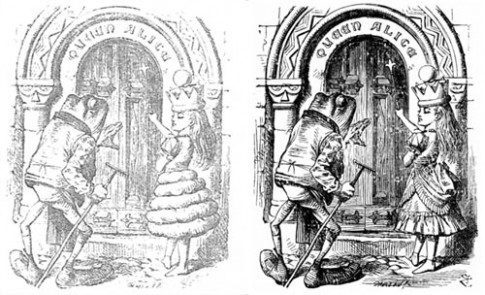
As the original illustrations were black and white, Alice’s dress had no color. Nowadays we often imagine the dress to be blue, but this is mainly thanks to Disney’s 1951 cartoon movie.
The first colored images of Alice and her dress did not appear in books, but on merchandise products. For example, this music cover for ‘The Wonderland Quadrilles’, published around 1872, shows Alice in a red dress. The illustrations are by lithographer Alfred Concanen, but the designs are after Tenniel (Tenniel’s monogram is on the front wrapper, and his permission inside), and were approved by Lewis Carroll.
In 1875, a Dutch translation was published that contained 7 colored illustrations, redrawn from Tenniel’s. These show Alice in a yellow dress.
In a stage version of the story by Henry Savile Clarke in 1886-1887, Alice’s costume was white. This decision was endorsed by Carroll for the next production (Vaclavik, 2014). Originally there was supposed to be a second stage dress, which was greeny-blue, however technical difficulties limited Alice to only one gown (Richards, 2021).
In 1887, Alice also appeared with a (rather strangely and carelessly colored) red dress on the front cover of the People’s Edition of the book (that had black and white illustrations inside):
The first official colored illustrations appear in the Nursery Alice (1889). These were redrawn and enlarged by Tenniel, and approved by Carroll. In these, Alice’s dress is yellow. Perhaps this choice was inspired by the colored illustrations in the Dutch edition?
The same year, Carroll designed a ‘Wonderland postage-stamp case’. This also featured an image of Alice in a yellow dress.
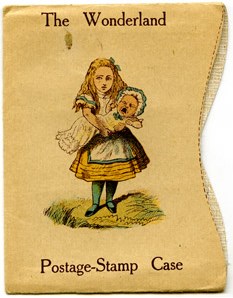
In 1892, the company Barringer, Wallis and Manners produced biscuit tins under Lewis Carroll’s supervision (Jaques and Gidders). These feature Alice for the first time in a blue dress:
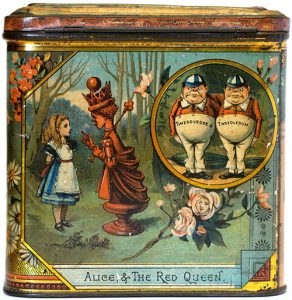
Image from Brighton Toy & Model Museum
The first time we see Alice in a blue dress in book illustrations, is in Thomas Crowell’s American 1893 edition, that has one color frontispiece:
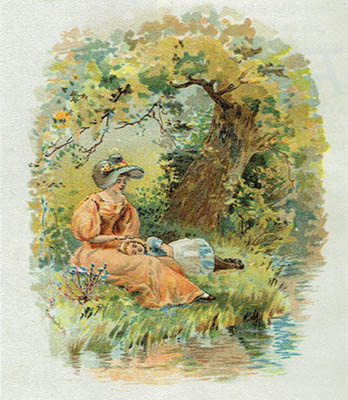
In Macmillan’s 1903 “The Little Folks’ Editions” of both “Alice’s Adventures in Wonderland” and “Through the Looking-Glass”, Alice’s dress is also blue. In their 1907 edition, however, her dress is red again.

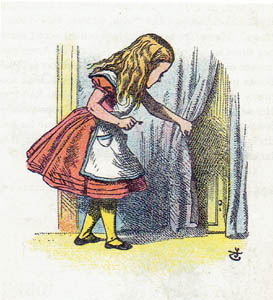
(Aliceinwonderland150.com and Burstein)
Many other variations on Tenniel’s illustrations have followed ever since. But Tenniel never colored her dress blue.
Alice was depicted with blonde hair since the very beginning, even though Alice Liddell was a brunette.
When Lewis Carroll drew Alice in his original manuscript, he also did not make her resemble the real Alice. According to Batey (51), his drawings of her were clearly influenced by Dante Gabriel Rosetti, Arthur Hughes, and other Pre-Raphaelite art, which he admired. His Alice has a Pre-Raphaelite look, and she resembles ‘The Lady with the Lilacs’ – a painting made by Hughes in 1863 for Carroll, which hung in his rooms at Christ Church.

“The Lady with the Lilacs”, compared to Carroll’s drawings of Alice – the first two show the fictional character of Alice, the last is his drawing of the real Alice at the end of the manuscript, which he decided to cover with a photograph of her.
The puppy
Tenniel did not just draw a random dog. His rendition of the puppy is a Norfolk Terrier (Gardner, “Anniversary edition”).
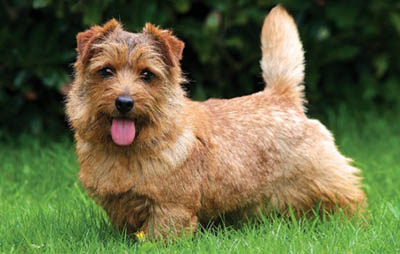
The Mad Hatter
It is often suggested that Tenniel made the Mad Hatter resemble the politician Disraeli. There is not much proof for this claim, however if you compare a picture of Disraeli that appeared in Vanity Fair with the illustration of the Hatter, similarities can be seen. Still, the Hatter does not resemble most Disraeli caricatures drawn by Tenniel.
Left: Disraeli by Carlo Pellegrini (in Vanity Fair). Middle: Disraeli by Tenniel (in Punch, 1871). Right: Tenniel’s Mad Hatter
The March Hare
Tenniel drew the March Hare with straw on his head. At Carroll’s time, this was a symbol of madness. He refers to it in his ‘Nursery Alice’: “That’s the March Hare, with the long ears, and straws mixed up with his hair. The straws showed he was mad-I don’t know why.”
The Duchess
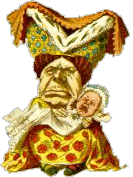 One of the few instances where Tenniel’s illustrations deviate from Carroll’s textual descriptions, is the illustration of the Duchess. According to the text, the Duchess has a very “sharp little chin”. This, however, is not to be seen in Tenniel’s visualisation of her.
One of the few instances where Tenniel’s illustrations deviate from Carroll’s textual descriptions, is the illustration of the Duchess. According to the text, the Duchess has a very “sharp little chin”. This, however, is not to be seen in Tenniel’s visualisation of her.
The portrait of ‘A Grotesque Old Woman’ (1513), painted by the Flemish Renaissance painter Quintin Massys, or a very similar drawing like Francisco Melzi’s (1510-20), could have served as a model for Tenniel’s Duchess.
The ‘Ugly Duchess’ on the painting is supposed to be Margaretha ‘Maultasch’, a fourteenth-century duchess of Tyrol and princess of Carinthia. She had the reputation of being the ugliest woman in history (Gardner, “The Annotated Alice” 82 and Stoffel 76).
We don’t know how well the painting (or drawing) resembles the real duchess, because it was painted 200 years after her death. It may be that she was not actually ugly, but that this was a wrong interpretation of the artist, by taking her nickname too literally (‘maultasch’ translates as ‘pocket-mouth’). According to the German Wikipedia page (Wikipedia, “Margareta von Tirol”), ‘Maultasch’ meant ‘slut’. William A. Baillie-Grohman (Baillie-Grohman) claims that it means ‘a box on the ears’ – alluding to a family incident of the Duchess with political consequences. If the latter is true, it could explain why the Duchess in “Alice’s Adventures in Wonderland” is under sentence of execution for ‘boxing the Queen’s ears’…

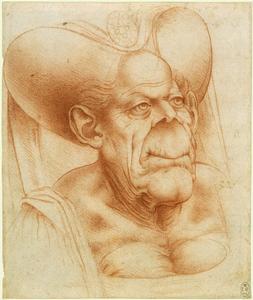
The ape in the pool of tears
“They were indeed a queer-looking party that assembled on the bank–the birds with draggled feathers, the animals with their fur clinging close to them, and all dripping wet, cross, and uncomfortable.”
When we take a good look at Tenniel’s drawings of the animals from the pool of tears, we can see that the party mainly consist of birds, and some other animals that are used to living near the water (crabs and a beaver). The most remarkable animal in the party is the ape, who is present in both illustrations. It is often said that this ape is a reference to Darwin’s ‘The Origin of Species’ (1859).
Dodgson started to write ‘Alice’s Adventures Under Ground’ only three years after Darwin had published his book. Dodgson was aware of the implications of Darwin’s work, and owned several books by Darwin and his followers. Perhaps Dodgson introduced the ape as a sly comment on the controversy surrounding the evolution theory. After all, in this scene these creatures emerged from the water and came to land. In any way, it must have been Dodgson’s idea, not Tenniel’s, as the ape was already present in Dodgson’s own drawing for Alice’s Adventures Under Ground.
The ape is not mentioned in the text about the pool of tears. However, David Lockwood suggests that the ape is Pat, the White Rabbit’s servant. Judging by his language (“Sure then I’m here! Digging for apples, yer honour” / “Sure, it’s an arm, yer honour!’ (He pronounced it ‘arrum.’)”), Pat is Irish. Furthermore, ‘Irish apple’ is a slang term for ‘potato’ (although apparently the expression was only used by English people). Many cartoons of the Victorian period depict Irishmen as ape-like creatures. In ‘Punch’ cartoons of the mid to late nineteenth century, the Irish worker is nearly always represented with a bestial jaw and beetling brows, and is invariably named ‘Pat’ or ‘Paddy’ (Lockwood).
The dodo
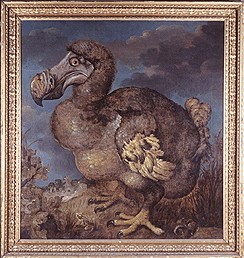
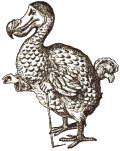 In the Oxford University Museum of Natural History you can find this painting of the Dodo (1651) by Jan Savery and the remains of a dodo. Both of these probably provided inspiration for Alice’s Adventures in Wonderland. In his diaries, Dodgson wrote that he took Alice, Edit and Miss Prickett to the newly opened museum in 1863 (Davies 2).
In the Oxford University Museum of Natural History you can find this painting of the Dodo (1651) by Jan Savery and the remains of a dodo. Both of these probably provided inspiration for Alice’s Adventures in Wonderland. In his diaries, Dodgson wrote that he took Alice, Edit and Miss Prickett to the newly opened museum in 1863 (Davies 2).
Father William
The illustrations of Father William may be based on Benjamin Jowett, an Oxford professor who taught Greek at Christ Church (Day). Father William’s strange activities that are described in the poem, may also refer to his attempts at reformations (Jones and Gladstone).
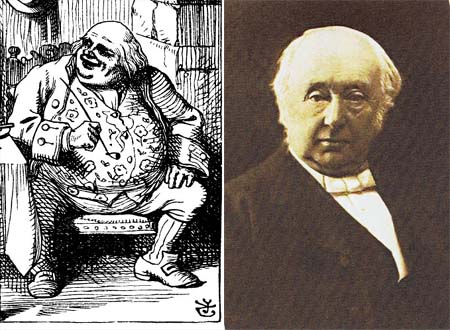
Father William (by John Tenniel) versus Benjamin Jowett (photo by Charles Dodgson)
The Caterpillar
When you take a close look at the picture of the Caterpillar, you’ll see that his nose and chin are really two of its legs!
The way Tenniel drew the nose and chin, and upper part of its head, also bear a resemblance to the character Punch, after which the magazine he drew for was named, and a character he and his colleagues often drew in satirical illustrations. There is no evidence that this was an intentional reference; it could be that he just drew the Caterpillar’s face in the style he was used to.

Image 1: Tenniel’s Caterpillar. Image 2: Tenniel’s Punch character in ‘Waiting to know’. Image 3: Joseph Swain’s Punch character in ‘The monster slain’.
The Caterpillar’s sleeves resemble those of an academic gown, so maybe Carroll was parodying a Christ Church academic.
Father William and the eel
In the backgroud of the illustration of father William balancing an eel on his nose, you can see a bridge-like construction. This is an eel trap, which is built across rivers and traps eels through conical baskets with small openings (Benham).
The Mock Turtle
Green turtle soup became a very popular soup around 1728, but its popularity caused the overhunting of turtles. This lead to extremely high prices for this kind of soup. Mock turtle soup was invented in the mid-18th century as a cheaper version of green turtle soup and was usually made from veal. This is why Tenniel drew his Mock Turtle with the head, hind hoofs, and tail of a calf (Gardner, “The Annotated Alice” 124 and Wikipedia, “Turtle Soup”).
The Liddell children certainly knew about turtle soup. It was always on the menu on royal occasions, like when the Queen’s eldest son’s 18th birthday was celebrated at Christ Church in 1859. Christ Church children were known to have ridden on the turtle’s backs before they were made into soup. Afterwards, the huge turtle shells were hung on the kitchen walls. (Batey 18)
The King and Queen of Hearts
It is interesting to note that Tenniel drew all playing card characters to resemble their paper equivalents, except for the Queen of Hearts – her dress resembles that of the Queen of Spades playing card (from the 1840’s De La Rue pack) (Hancher, 1985)!
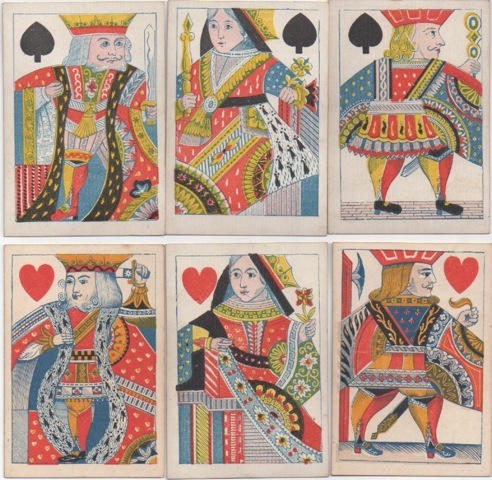
image courtesy of Ken Lodge
It is unknown why he made that decision, or whether it perhaps was just a mistake.
The same goes for the King of Hearts: although he is wearing the ‘correct’ outfit in Tenniel’s illustration, Tenniel drew him with a moustache. The King of Hearts on the original playing card did not have one (while all three other kings had) (Chang).
The Knave of Hearts
Tenniel shaded the nose of the Knave of Hearts on trial. This was a convention among cartoonists to suggest that the portrayed person is a drunk. Victorians thought of criminals as heavy drinkers. Tenniel also darkened the noses of the Duchess and the Queen of Hearts (Gardner, “Anniversary edition” 145).
Michael Hancher (Hancher, 1985) suggests another theory: he claims that the shaded noses are an indication of guilt. As the stolen tarts are made of “pepper, mostly”, anyone who comes in contact with them gets a red nose (because of the sneezing). This would also explain the noses of the Duchess and Queen.
In the picture where the Queen points at Alice, the Knave carries a crown on a pillow. From the 18th century on, it was standard to depict this crown (which is St. Edward’s crown, the state crown of England) on ace of spades playing cards. It would be familiar for Victorian readers (Hancher, 1985). So by including the crown, Tenniel makes sure the Ace is also represented in the crowd of playing cards!
John Tufail (Tufail) claimed that the Knave of Hearts is actually the Knave of Clubs, because the symbols on his tunic are clubs in stead of hearts. But if you look at the playing cards from the De La Rue deck above, you can see that the clover motif actually appears on the Knave of Hearts playing card.
Glass building
In the background of the illustration of the Queen of Hearts pointing at Alice, you can see a large hemispherical glass building. This is probably a reference to the huge greenhouses that were built in Tenniel’s time, like the ‘Crystal Palace’ (which was named so by Punch magazine), that was designed to house the Great Exhibition in Hyde Park in 1851. These glass domes were seen as a symbol of British progress (Hancher, 1985).
The frontispiece
When drawing the frontispiece for “Alice’s Adventures in Wonderland”, Tenniel probably consulted Charles H. Bennett’s engraving called “Man tried at the Court of the Lion” (1857). Not only is the organisation of the image quite similar, also several characters look very much alike. The Queen resembles the Lion, the King the owl, the Knave the dog, etcetera (Hancher, 2019 55).
Alice going through the Looking-Glass
There are two pictures of Alice crawling through the mirror on the chimney-piece. In the second picture everything is reversed. Tenniel even reversed his monogram!
The White Knight
Ever noticed that the picture of the White Knight bears a resemblance to Tenniel himself? John Tenniel however didn’t have a handlebar mustache at the time he drew the illustration, and had more hair then.
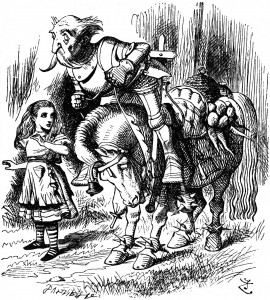

John Tenniel in several periods of his life. 1: 1895; 2: 1895 (self portrait); 3: ca. 1867-71; 4: “late 1860s-early 1870’s” (Hancher, 2019 93)
In 1895, M. H. Spielmann speculated that the White Knight was a caricature of Tenniel’s friend and Punch colleague, Horace ‘Ponny’ Mayhew. Indeed Mayhew also looks similar to the White Knight, especially because his nose is more pronounced and hooked than Tenniel’s. Tenniel, however, denied this in a letter (albeit 20 years later), claiming that “the resemblance was purely accidental, a mere unintentional caricature, which his friends, of course, were only too delighted to make the most of. P. M. was certainly handsome, whereas the White Knight can scarcely be considered a type of ‘manly beauty’. (Hancher, 1985)”
In a letter to Tenniel, Lewis Carroll wrote: “The White Knight must not have whiskers; he must not be made to look old”. As we can see, Tenniel did not oblige. This may lead to the suspicion that he had, in fact, someone specific in mind that he wanted to portray.
Batey (89) suggests the painting “Sir Isumbras at the Ford” by John Everett Millais could be a source for Tenniel’s White Knight.
According to Janis Lull, the items the White Knight carries on his horse can all be linked to an event in the story. We see among others Tweedledum’s rattle, a bottle of wine (refers to the banquet), a wooden sword (from Tweedledum), fire irons (the Knight sliding down the poker), a bell (the doorbell Alice will ring), and so on (Lull).
Alice on the train
 The man dressed in white paper, who Alice meets when she travels by train through the 3rd square, may be a political joke. According to Martin Gardner, Tenniel’s illustration shows a cartoon of Benjamin Disraeli, who was Prime Minister when Carroll lived. Carroll and Tenniel may have had in mind the ‘white papers’ (official documents) with which such statesmen are surrounded. Before he illustrated the Alice books, Tenniel had once portrayed Disraeli in a Government White Paper suit (Gardner, “The Annotated Alice” 218).
The man dressed in white paper, who Alice meets when she travels by train through the 3rd square, may be a political joke. According to Martin Gardner, Tenniel’s illustration shows a cartoon of Benjamin Disraeli, who was Prime Minister when Carroll lived. Carroll and Tenniel may have had in mind the ‘white papers’ (official documents) with which such statesmen are surrounded. Before he illustrated the Alice books, Tenniel had once portrayed Disraeli in a Government White Paper suit (Gardner, “The Annotated Alice” 218).
Michael Hancher (Hancher, 1985) disputes this, however, as the man in white paper does not have the obvious chin and goatee, which normally is present in Tenniel’s caricatures of Disraeli.
The drawing of Alice appears to be a composition of ‘My First Sermon’ and ‘My Second Sermon’, two paintings by the Victorian artist John Everett Millais. Carroll mentioned the first painting in his dairy, in an entry describing a visit to Millais (Gardner, “The Annotated Alice” 218 and Jones and Gladstone 65).
There might be another painting that served as an inspiration for Tenniel’s illustration. The image on the left is a painting from Augustus Leopold Egg, called “The Travelling Companions” (1862). There are indeed striking resemblances if you look at the compartment windows and hats (Hancher, 2019 119).
However, the similarities don’t necessarily mean that one or more of these paintings served as an inspiration, as apparently there were many images in Tenniel’s time that show little girls in these kind of mass-produced railway carriages, dressed like Alice, including the muff and feathered hat, which were very fashionable in that time.
Haigha, the Anglo-Saxon messenger
Haigha is being described as “wriggling like an eal … with his great hands spread out like fans on each side”. The White King tells Alice that these are Anglo-Saxon attitudes. Indeed, this posture can be seen in Anglo-Saxon images from about the ninth- to eleventh-century. Besides the stance, the outfit of the messenger also looks Anglo-Saxon.
Compare Tenniel’s illustration for example with the figure of King Edgar in the foundation charter for the new Minster at Winchester (Borchers):

The Lion and the Unicorn
Various turns of phrase, together with Tenniel’s illustration, suggest that the Unicorn is prime minister Benjamin Disraeli (who Carroll, as a Tory, supported), and the Lion his Liberal rival, William Ewart Gladstone (Gardner, “The Annotated Alice” 288).
There is no real proof for this, however many people do think they resemble Tenniel’s cartoons of them which he drew for the magazine ‘Punch’.
Michael Hancher (Hancher, 1985) disputes the likeliness. Unicorns were often depicted with a goatee in British heraldry (as they were supposed to be partly goatlike), so this does not necessarily refer to Disraeli’s beard.
Tweedledee and Tweedledum
The brothers Tweedledee and Tweedledum are clearly meant to be identical twins, who are mirror images of eachother (thereby supporting the Looking-Glass theme of the book). If we take a look at the image where they are preparing for battle, the right hand of one of the brothers mirrors the left hand of the other. Also, the folds on the blanket each trails behind him are identical. If one of them moved somewhat to the left, they would stand before eachother as before a mirror.
The Tweedle brothers very much resemble ‘John Bull’ (a fictional character representing England), who Tenniel drew several times in cartoons for the magazine Punch (like the example below, from 27 April 1861):
Bull is wearing a ‘skeleton suit’, which was standard for schoolboys during Tenniel’s own childhood (Hancher, 1985).
The illustration of Alice helping Tweedledum and Tweedledee to dress, resembles another ‘Punch’ cartoon, drawn by John Leech (“A physical force chartist arming for the fight”, Punch, July-December 1848) (Hancher, 1985).
The clasping of their hands in the first illustration reminds us of the characteristically pose from the Siamese Twins Chang and Eng Bunker, who toured in freakshows that were widely covered in the Victorian press (Lockwood).
The King’s men
The Alice books contain many instances of both Dodgson and Tenniel making fun of the mid-Victorian obsession with all things medieval. Tenniel’s illustration of the King’s men who rush to Humpty Dumpty after he has fallen off the wall, is an example.
The figure who lies face upwards and arms outstretched in the centre foreground, is a reference to the long-standing iconographical tradition in paintings of battle scenes, where these figures serve as a focal point in an otherwise confusing mêlée of arms and legs.
While the figures in the background of Tenniel’s picture are conventional medieval knights, whose armour suggests that they date from the thirteenth of fourteenth centuries, the infantrymen in the foreground wear the distinctive helmets and baggy breeches popular during the renaissance (from early sixteenth century), and bear arquebusses or muskets. Therefore, the picture is chronologically impossible. The renaissance soldiers may be the Swiss Guard, who’s task is to protect the pope (Lockwood).
Queen Alice’s door
The outer edges of Queen Alice’s door bear a remarkable resemblance to the Norman west doorway of St. Ebbe’s church in Oxford. The church was comprehensively rebuilt and enlarged from 1862 to 1868, but this door dates from circa 1087. The general shape of the door and the chevron (zig-zag) pattern is typical for Norman architecture, but the design of the column head below is also strikingly similar to that in Tenniel’s illustration (discovered by Judith van den Berg).
Ballet dancing positions
Tenniel’s father was among others a dancing master, and there are several indirect references to the ballet in his ‘Punch’ cartoons. In his illustrations for ‘Alice’s Adventures in Wonderland’, we can find most of the starting and ending positions of the classical ballet:
The lobster turns out his feet in a roughly straight line, with the heels touching, which corresponds to the first position in ballet. The Knave of Hearts stands with his feet turned outward, nearly in a straight line and separated by several inches, as in second position. Frankie Morris points out, that in the picture of the two footmen, the Fish stands in the third position (one foot before the other, with the heel resting against the instep), while the Frog performs a demi-plié in fifth position (one foot before the other, the heel resting against the big toe). Father William’s son appears to be standing in the fourth position. Furthermore, Alice’s stance in the picture with the Dodo looks very unnatural and unconfortable – perhaps she has just completed a pirouette? (Lockwood)
The engraver
In case you’re wondering whose name it is that you see on most of the illustrations (not Tenniel’s monogram): it is the last name of Edward Dalziel, the engraver (Gardner, “The Annotated Alice” 186).
In many editions of ‘Alice’s Adventures in Wonderland’, you can find the name “B. ROLLITZ” on the left margin of the card hidden by the six of spades, in the illustration of the shower of cards . B. Rollitz engraved new plates for the Limited Editions Club publication in 1932. Many publishers copied these in stead of the original wood engravings from Dalziel (Gardner, “Anniversary edition” 146).
Colored “Nursery Alice” illustrations
In 1875, a Dutch translation of “Alice’s Adventures in Wonderland” was published, called “Lize’s Avonturen in het Wonderland”. The book contains 7 colored lithographs based on redrawn illustrations by lithography printer Emrik & Binger. It was the first time John Tenniel’s illustrations were colored. These illustrations were offered for sale to Macmillan & Co in 1876, but they refused them because they did not approve of their quality. Nevertheless, in 1881, Lewis Carroll ordered 30 copies of this translation (Ruizenaar 41).
As Carroll was well aware of this Dutch edition, it may have inspired him to publish his “Nursery Alice” edition, which contained 20 colored illustrations. Although that book was published in 1889, Carroll conceived the idea in the beginning of 1881.
Not only may seeing a colored edition have inspired him to produce his own version, the actual colors may have been re-used as well, as some of the colors in the Dutch edition reappear in the “Nursery Alice”. Especially notable is Alice’s dress, which is yellow in both versions. Perhaps Carroll showed the illustrations from “Lize’s Avonturen in het Wonderland” to Tenniel, when he asked him to colorize his originals for “Nursery Alice”? (Ruizenaar 53)
Works cited
Baillie-Grohman, William A.. The Land in the Mountains. J.B. Lippincott Company, 1907.
Batey, Mavis. The Adventures of Alice. The story behind the stories Lewis Carroll told. Macmillan Children’s Books, 1991.
Benham, Philip. Jabberwocky, issue 6, winter 1970.
Borchers, Melanie. “A linguistic Analysis of Lewis Carroll’s Poem ‘Jabberwocky'”. The Carrollian, no. 24, autumn 2009, published in November 2013.
Burstein, Mark. “Am I blue?“. Knight Letter, Winter 2010, volume II issue 15, nr. 85.
Chang, Howard. “Annotating Alice for Chinese Readers”. Presentation during the Lewis Carroll Society of North America spring meeting, San Francisco, 1 April 2017.
Davies, Mark. Talk during the October meeting of the LCSNA. Described in: Morgan, Chris. “VirtuAlice 3: WCLD Radio Alice Is on the Air!” Knight Letter, Fall 2021, Volume III Issue 7, no. 107.
Day, David. Alice’s Adventures Decoded. Doubleday Canada, 2015.
Gardner, Martin. The Annotated Alice. Wings Books, 1998.
Gardner, Martin. The Annotated Alice. 150th Anniversary deluxe edition, W.W. Norton & Company, 2015.
Hancher, Michael. The Tenniel illustrations to the ‘Alice’ books. The Ohio State Press, 1985.
Hancher, Michael. The Tenniel illustrations to the ‘Alice’ books. The Ohio State Press, second edition, 2019.
Jaques, Zoe and Eugene Gidders. Lewis Carroll’s Alice’s Adventures in Wonderland and Through the Looking Glass. A Publishing History. Ashgate Studies in Publishing History, Ashgate Publishing, 2016.
Jones, Jo Elwyn and J. Francis Gladstone. The Alice Companion. NYU Press, 1998.
Lockwood, D. “Pictorial Puzzles from Alice”. The Carrolian, no. 14, autumn 2004.
Lull, Janis. “The Appliances of Art: The Carroll-Tenniel Collaboration in Through the Looking-Glass”. Lewis Carroll: A Celebration, edited by Edward Guiliano, Clarkson N. Potter, 1982.
Richards, Catherine. “Savile Clarke ‘Alice’ Productions Articles.” Compiled from: CAUSERIE, The Court Circular, Saturday 1 January 1887, pp. 5-6, https://lewiscarrollresources.net/savileclarke/articles/Article1036.pdf, 2021, accessed on 17 November 2021.
Ruizenaar, Henri. “The first Dutch Alice.” In: Lize’s Avonturen in het Wonderland, 1875 reissue by the Lewis Carroll Genootschap, Phlizz series No 2, 2021.
Schiller, Justin and Selwyn Goodacre. Alice’s Adventures in Wonderland: An 1865 Printing Redescribed. The Jabberwock, 1990.
Stern, Jeffrey. “Lewis Carroll the Pre-Raphaelite”. Lewis Carroll Observed, by Edward Guiliano, Clarkson N. Potter, 1976.
Tufail, John. “A case of mistaken identity”. Omegabrands, www.omegabrands.com/carroll/knave.html, accessed on 19 January 2019.
Vaclavik, Kiera. “The Dress of the Book: Children’s Literature, Fashion and Fancy Dress”. In: Carrington and Harding. Beyond the Book: Transforming Children’s Literature. Newcastle Upon Tyne: Cambridge Scholars’ Publishing, 2014, pp. 62–76.
Vaclavik, Kiera. Presentation. ‘Alice 150’ conference. New York, 9 October 2015.
Wikipedia. “Margareta von Tirol”. de.wikipedia.org/wiki/Margarete_von_Tirol#Der_Beiname_.E2.80.9EMaultasch.E2.80.9C, accessed on 11 January 2020.
Wikipedia. “Turtle Soup”. https://en.wikipedia.org/wiki/Turtle_soup, accessed on 25 January 2020.
